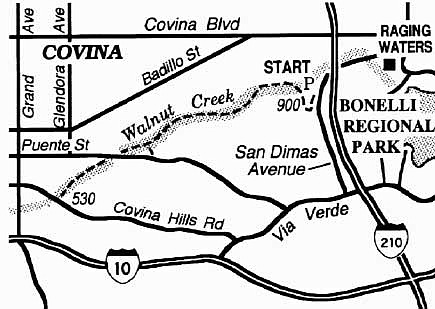 Facebook
Facebook
 X
X
 Instagram
Instagram
 TikTok
TikTok
 Youtube
Youtube
Walnut Creek and its associated parkland stretches through the San Gabriel Valley communities of San Dimas and Covina. A wide and well-traveled equestrian and hiking trail goes the length of the park, crossing the streambed several times. Now dry, this watercourse will likely revive with the first rains of late autumn. Plenty of oaks, sycamores, willows, and assorted non-native ornamental trees -- but relatively few walnut trees -- line the banks.
Steep south canyon walls make the canyon a cool haven on all but the hottest days. Often on winter mornings the canyon bottom is a frosty wonderland, since it acts as a sink for cold, dense night air slinking down the slopes of the nearby San Gabriel Mountains.
You can begin hiking at the roadside parking area on the west side of San Dimas Avenue, one mile north of Via Verde's interchange with Interstate 210. The trail zigzags down the road embankment to the west and enters densely shaded Walnut Canyon. Down along the bottom are several splits in the trail: the first three are merely alternate routes that go along the opposite bank or up onto the steep south slope before returning to the main trail; the fourth is a spur trail that connects with Puente Street.
Past the Puente Street bridge there's not much of a trail at all, and in winter you could find yourself sloshing through the shallow water. In a while the water enters a cement flood-control channel to be whisked efficiently away. You climb up on the left bank of the flood-control channel. Covina Hills Road lies just ahead, about 3.5 miles into your walk. This is a good place to end the trip, assuming you've planted a second car there in advance. Otherwise, at any point along the canyon descent, you can stop, turn around, and return the same way.


Walnut Creek and its associated parkland stretches through the San Gabriel Valley communities of San Dimas and Covina. A wide and well-traveled equestrian and hiking trail goes the length of the park, crossing the streambed several times. Now dry, this watercourse will likely revive with the first rains of late autumn. Plenty of oaks, sycamores, willows, and assorted non-native ornamental trees -- but relatively few walnut trees -- line the banks.
Steep south canyon walls make the canyon a cool haven on all but the hottest days. Often on winter mornings the canyon bottom is a frosty wonderland, since it acts as a sink for cold, dense night air slinking down the slopes of the nearby San Gabriel Mountains.
You can begin hiking at the roadside parking area on the west side of San Dimas Avenue, one mile north of Via Verde's interchange with Interstate 210. The trail zigzags down the road embankment to the west and enters densely shaded Walnut Canyon. Down along the bottom are several splits in the trail: the first three are merely alternate routes that go along the opposite bank or up onto the steep south slope before returning to the main trail; the fourth is a spur trail that connects with Puente Street.
Past the Puente Street bridge there's not much of a trail at all, and in winter you could find yourself sloshing through the shallow water. In a while the water enters a cement flood-control channel to be whisked efficiently away. You climb up on the left bank of the flood-control channel. Covina Hills Road lies just ahead, about 3.5 miles into your walk. This is a good place to end the trip, assuming you've planted a second car there in advance. Otherwise, at any point along the canyon descent, you can stop, turn around, and return the same way.
